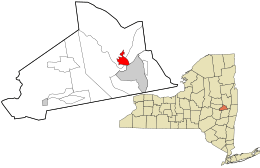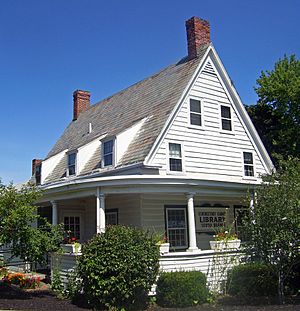Scotia, New York facts for kids
Quick facts for kids
Scotia, New York
|
|
|---|---|
|
Village
|
|

Location in Schenectady County and the state of New York.
|
|
| Country | United States |
| State | New York |
| County | Schenectady |
| Town | Glenville |
| Area | |
| • Total | 1.79 sq mi (4.63 km2) |
| • Land | 1.69 sq mi (4.37 km2) |
| • Water | 0.10 sq mi (0.25 km2) |
| Elevation | 243 ft (74 m) |
| Population
(2020)
|
|
| • Total | 7,272 |
| • Density | 4,308.06/sq mi (1,663.31/km2) |
| Time zone | UTC-5 (Eastern (EST)) |
| • Summer (DST) | UTC-4 (EDT) |
| ZIP code |
12302
|
| Area code(s) | 518 |
| FIPS code | 36-65893 |
| GNIS feature ID | 0964672 |

Scotia is a small village located in Schenectady County, New York, United States. It became an official village in 1904. In 2020, about 7,272 people lived there. Scotia is part of the larger town of Glenville. It is connected to the city of Schenectady by the Western Gateway Bridge, which crosses the Mohawk River.
Contents
History of Scotia
The land where Scotia now stands was bought from the Mohawk people in the 1600s. A man named Alexander Lindsay Glen, who was from Scotland, bought the land. He named his new estate Scotia, which is the Latin word for "Scotland," to honor his home country.
Scotia was an important place during wars. Soldiers camped there during the French and Indian War in 1754 and again during the War of 1812. In the 1800s, Scotia was famous for making brooms. At one point, they made over a million brooms every year!
In the 1900s, many people who worked for big companies in Schenectady, like General Electric, chose to live in Scotia. It became a busy community where people lived and then traveled to work. During World War II, a large supply base called the Scotia Naval Supply Depot operated there from 1942 to 1971. It employed more than 2,000 workers.
Historic Buildings in Scotia
Scotia has several old and interesting buildings:
- Glen Sanders Mansion: Parts of this building date back to 1713.
- Abraham Glen House: This house was built in the 1730s.
- Flint House: This building is from the early 1800s.
- First Baptist Church: Built in 1872.
- Holland House (W.T. Mynderse mansion): Built in 1914.
- Scotia Reformed Church: The church group started in 1818, and the current building was built in 1952.
- United States Post Office: Built in 1940. Inside, there is a special painting called The Glen Family Spared by French and Indians – 1690. It was painted by Amy Jones (artist) in 1941. This building is listed on the National Register of Historic Places.
Where is Scotia?
Scotia is located on the north side of the Mohawk River. The village covers about 4.6 square kilometers (1.79 square miles). Most of this area is land, about 4.4 square kilometers (1.69 square miles). A smaller part, about 0.3 square kilometers (0.10 square miles), is water.
People in Scotia
The number of people living in Scotia has changed over the years. Here's how the population has grown and changed:
| Historical population | |||
|---|---|---|---|
| Census | Pop. | %± | |
| 1880 | 222 | — | |
| 1910 | 2,957 | — | |
| 1920 | 4,358 | 47.4% | |
| 1930 | 7,437 | 70.7% | |
| 1940 | 7,960 | 7.0% | |
| 1950 | 7,812 | −1.9% | |
| 1960 | 7,625 | −2.4% | |
| 1970 | 7,370 | −3.3% | |
| 1980 | 7,280 | −1.2% | |
| 1990 | 7,359 | 1.1% | |
| 2000 | 7,957 | 8.1% | |
| 2010 | 7,729 | −2.9% | |
| 2020 | 7,272 | −5.9% | |
| U.S. Decennial Census | |||
In 2010, there were 7,729 people living in Scotia. About 23% of the people were under 18 years old. The average age of people in Scotia was 37.2 years. There were slightly more females (51.6%) than males (48.4%) living in the village.
Life in Scotia
Scotia is served by the Scotia-Glenville Central School District. Some schools, like Lincoln and Sacandaga elementary schools, are right in the village. Scotia-Glenville High School and Scotia-Glenville Middle School are just outside the village limits. There is also a private school, Mekeel Christian Academy, which is located in the old Scotia High School building.
Residents of Scotia can enjoy many activities at Collins Park and Freedom Park. In winter, people can go sledding and ice skating. In summer, there are activities like baseball, tennis, swimming, fishing in the pond and river, picnics, concerts, and even waterskiing on the Mohawk River.
Getting Around Scotia
Scotia has several important roads. New York Route 5 runs through the village. It is also the end point for both Route 50 and Route 147, which lead to Saratoga County.
The Western Gateway Bridge connects Scotia to Schenectady. The first bridge was built in 1923-1925, and it was replaced in 1971. Before that, an older wooden bridge called the Burr Bridge crossed the Mohawk River from 1808 to 1925.
In the past, Scotia was also served by several railway lines, including the New York Central, the Delaware and Hudson, and the Boston and Maine. There was also an electric train line called the Fonda, Johnstown and Gloversville Railroad.
Today, there are two airports nearby in the town of Glenville. Mohawk Valley Airport is a private airport open to the public. Schenectady County Airport is a public airport used by both civilians and the military.
Famous People from Scotia
Many interesting people have connections to Scotia:
- Helmut Karl Buechner (1918–1975): An ecologist and field biologist, born in Scotia.
- Joe Cremo (born 1996): A professional basketball player, born in Scotia.
- Philip Dalton (1903–1941): A military scientist and pilot, born in Scotia.
- Laura Diaz (born 1975): A professional golfer on the LPGA Tour, born in Scotia.
- Robert Doherty (1885–1950): An electrical engineer and president of Carnegie Mellon University, who died in Scotia.
- Saul Dushman (1883–1954): A physical chemist, who lived and died in Scotia.
- Conyers Herring (1914–2009): A solid-state physicist, born in Scotia.
- Steve Kuczek (1924–2010): A major league baseball player, who died in Scotia.
- Kathleen Paige (born 1948): A rear admiral in the U.S. Navy.
- James Parry (born 1967): A well-known internet personality, born in Scotia.
- David Pietrusza (born 1949): An author who lived in Scotia.
- George Runner (born 1952): A former California state senator, born in Scotia.
See also
 In Spanish: Scotia (Nueva York) para niños
In Spanish: Scotia (Nueva York) para niños

